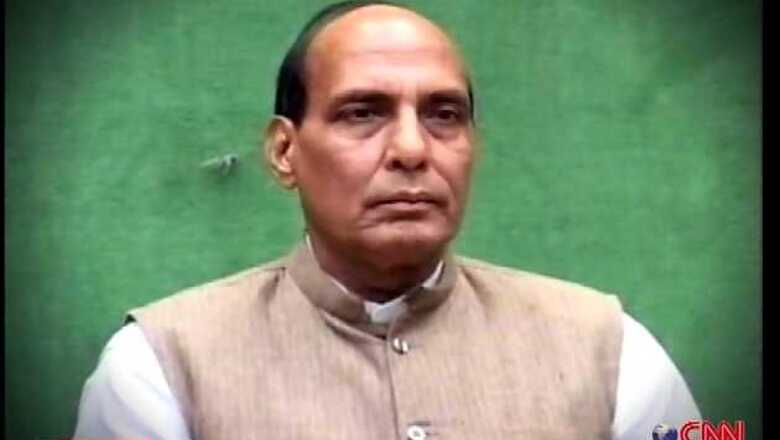
views
New Delhi: Rajnath Singh, who was elected President of BJP on January 23, finds himself in the familiar role of leading the party at a time when the party is dogged by factional feud and the Lok Sabha polls not too far away. 61-year-old Singh from Uttar Pradesh, who takes over from Nitin Gadkari, returns to the political terrain in which the low-profile, soft-spoken and articulate leader found himself about six years ago when he was chosen by the saffron party to head it. General election is due in May 2014.
Singh's dramatic elevation to the top party post caps a period of big political churnings within BJP divided on re-electing Gadkari as president for a second time. It was Singh who had handed over the baton to Gadkari in December 2009. But in a sudden and dramatic last-minute twist, Gadkari, facing allegations of dubious funding of his company, was last night forced out of the race for BJP President's post for a second term and Rajnath emerged the consensus choice.
The party probably had little choice except to fall back on Singh s non-controversial image and a high degree of acceptability among rival groups in the organization. Singh has again been brought back by the party as chief just three days after the Congress elevated AICC general secretary Rahul Gandhi as Vice President.
How Singh will reshape the BJP to counter Congress charm offensive remains to be seen though he has often lauded BJP's democratic strength which has enabled a "commoner" like him to lead the party. From a college lecturer in Physics, Rajnath Singh's rise in politics has been gradual and steady during which he had been BJP chief from 2006 to 2009 and earned the reputation of being an able administrator as Union Minister twice and Chief Minister of Uttar Pradesh.
Currently a Lok Sabha member from Ghaziabad, Singh has emerged from the ranks as a political heavyweight in the party largely due to his proximity to BJP's spiritual mentor RSS.
After taking over BJP's reins from veteran leader LK Advani in December 2005, Rajnath Singh sought to rebuild the party by focusing on basic Hindutva ideologies and said there would be "no compromise" on building the Ram Temple in Ayodhya. However, he not only failed to steer the party to power in the 2009 general elections but BJP's poll tally dropped by 22 seats compared to 2004 Lok Sabha polls.
Born on July 10, 1951 at Bhabhaura village in Uttar Pradesh's Chandauli district, Singh obtained MSc degree in physics from Gorakhpur University and was appointed lecturer in the K B Post graduate degree college in Mirzapur in 1971.
Singh's association with Rashtriya Swayamsevak Sangh began in 1964 when he was only 13 year old. Even as lecturer he remained attached to RSS. Rising step by step, he began his political innings with BJP's student wing Akhil Bharatiya Vidyarthi Parishad (ABVP) in 1969 as its organising secretary in Gorakhpur and rose to become the secretary of the then Bharatiya Jan Sangh's Mirzapur unit in 1974.
During the Emergency, Singh joined Jaiprakash Narayan's movement and was arrested in July 1975 before being released in 1977. Singh made his debut in electoral politics when he became an MLA in Uttar Pradesh in 1977. In 1983, he became state Secretary of BJP and a year later he found himself leading the Uttar Pradesh unit of BJP's Youth Wing (BJYM).
His political rise continued with his elevation as National General Secretary of BJYM in 1986 and subsequently its National President in 1988. In the same year, Singh was elected member of Legislative Council in UP, a position he held till 1994, serving in between as Education Minister in the Kalyan Singh government until it was dismissed in December 1992 following the Babri Masjid demolition.
As Education Minister in UP, Singh had courted controversy by enacting the Anti-Copying Act which had opposition parties up in arms against him. Although active in UP politics for long, Singh's entry into Parliament came only in 1994 when he was given a Rajya Sabha ticket and also appointed Chief Whip of the BJP in the Upper House.
He was again brought back as party president in UP in 1997 in the wake of turbulence in state politics in 1997 and held the position till 1999 when he was first inducted into Atal Bihari Vajpayee-led NDA government as Surface Transport Minister.
It was under Singh that Vajpayee's dream project, National Highway Development Programme was launched. Singh's shuttle between UP and the Centre continued when on October 28, 2000, he was chosen to succeed veteran leader Ram Prakash Gupta as Chief Minister of UP. Singh remained at the helm till 2002 when the party faced a drubbing at the hands of Samajwadi Party and Bahujan Samaj Party in the state.
After BJP decided to support BSP chief Mayawati as chief minister of UP, a move Singh had opposed, he returned to national politics as BJP s national General Secretary. Soon, Singh, hailing from a farmer's family, again found his way back into the Vajpayee cabinet as Agriculture Minister after Ajit Singh parted ways with NDA in 2003.
Singh's journey up BJP hierarchy continued as he became its national President on December 31, 2005. His stint at the party helm saw BJP scoring some high points as it captured power in several states and also installed its first-ever government in Karnataka creating history by hoisting the saffron flag in the South as the ruling party.
An author with a book on "Unemployment, its Reasons and Remedies" to his credit, Singh is married with two sons and a daughter.




















Comments
0 comment